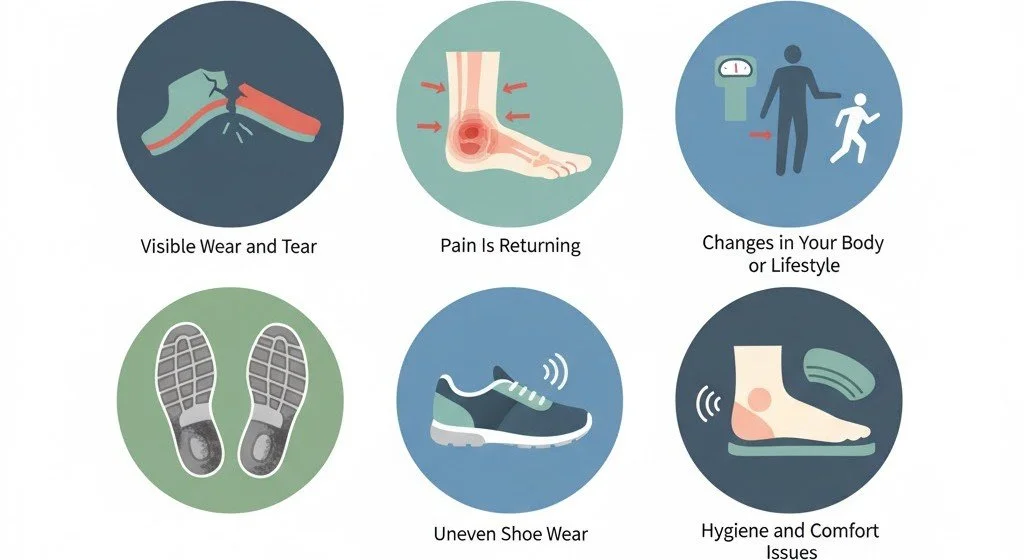Top Signs Your Orthotics Need Replacing
Orthotics are designed to give your feet the right support, correct alignment, and reduce pain—but they don’t last forever. Over time, daily wear and changes in your body can reduce their effectiveness. Knowing the signs that your orthotics need replacing can help you stay comfortable, prevent injuries, and keep moving with ease.
“Orthotics aren’t designed to last forever — most custom-made orthotics last between 2–5 years, while off-the-shelf options wear out within 6–12 months, depending on use and activity level”
Here are the key signs to look out for:
1. Visible Wear and Tear
If your orthotics are cracked, peeling, flattened, or losing their shape, they won’t provide the support they once did. Flattened arches or worn-down cushioning mean your feet are no longer being guided properly, which can put extra strain on your joints and muscles.
2. Pain Is Returning
One of the biggest signs is when foot, heel, or arch pain comes back—even though it was once relieved by your orthotics. You might also start to feel new discomfort in your knees, hips, or lower back, as poor alignment can affect your whole body.
“Studies show that worn orthotics can alter lower limb biomechanics, increasing the risk of knee and lower back strain by up to 25% in active adults.”
3. Changes in Your Body or Lifestyle
Our feet and bodies change over time. Weight changes, injuries, or increased activity levels can all alter the way your feet move. Orthotics that worked perfectly a few years ago may no longer match your current needs.
4. Uneven Shoe Wear
Take a look at the soles of your shoes. If you notice that one side is wearing faster than the other, or your shoes feel uneven when walking, your orthotics might not be doing their job anymore.Not every ingrown toenail can be managed at home. It’s generally safe to try gentle home care if:
5. Hygiene and Comfort Issues
Strong odours, worn coverings, or loss of cushioning are more than just inconvenient—they’re signs your orthotics are breaking down. Even if the shape looks intact, internal material fatigue can reduce comfort and effectiveness.
6. They’ve Reached the End of Their Lifespan
Most off-the-shelf orthotics last around 6–12 months, while custom-made pairs may last between 1–3 years depending on materials and usage. If you’ve had your orthotics for a while, it’s worth getting them checked, even if you don’t see obvious damage.
“Research indicates that orthotic lifespan varies by 40–60% based on user activity, footwear, and body weight”
7. You’ve Changed Activities or Footwear
If you’ve recently started running, standing longer at work, or switched to new footwear, your old orthotics may not be suited to the new demands. The right orthotic should match both your activity level and your shoes.
What to Do Next
Your orthotics play a vital role in maintaining healthy foot alignment, reducing pain, and improving movement — but even the best pair needs timely replacement. Ignoring early signs like pain, wear, or discomfort can lead to bigger issues over time.
At Podhills Podiatry in Sydney, we provide comprehensive orthotic assessments, adjustments, and custom-made orthotics designed to fit your unique lifestyle. Whether you’re experiencing discomfort or it’s simply time for a review, our expert podiatrists ensure your feet get the support they deserve.
Book your orthotics check-up at Podhills Podiatry today and step confidently towards lasting comfort and healthier movement.
FAQs
-
Most orthotics need replacement every 1–3 years, depending on their material and daily usage. If you’re noticing pain or wear, visit a podiatrist in Sydney for an orthotic assessment to ensure proper foot support.
-
Worn orthotics can cause foot, knee, and back pain, as they no longer support correct alignment. Over time, this can worsen existing foot issues like plantar fasciitis or flat feet.
-
Yes, a qualified podiatrist can evaluate whether your orthotics need repair, refurbishment, or full replacement. Sometimes minor adjustments or new coverings can restore comfort and effectiveness.
-
If your shoe fit feels uneven, you notice foot pain returning, or see visible flattening or cracks, it’s time to get your orthotics checked. Regular podiatry visits help ensure your orthotics match your changing lifestyle and foot structure.

